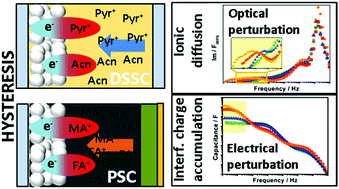Specific cation interactions as the cause of slow dynamics and hysteresis in dye and perovskite solar cells: a small-perturbation study†
Abstract
Hysteresis is one of the most remarkable features of perovskite solar cells; however, it is also present in other kinds of devices such as dye-sensitized solar cells. Hysteresis is due to underlying slow dynamic processes that interfere with the process of charge separation which depends critically on the selective contacts used. In this work we focus on the low-frequency (0.1–10 Hz) dynamics using impedance and intensity-modulated photocurrent spectroscopy and found that both perovskite solar cells (PSCs) and “viscous electrolyte containing” dye-sensitized solar cells (DSSCs) can be described on the same fundamental grounds. By comparing different electrolyte compositions in DSSCs and both methylammonium and formamidinium-based PSCs, we find a connection between the polar nature of the cations and the low-frequency component of these solar cells. There is evidence that in both cases ion transport and specific chemical interactions with the TiO2 surface give rise to the slow dynamics and the hysteresis. This is mainly inferred from the slope of the capacitance vs. applied voltage which shows accumulation behavior for the formulations with higher dipole moments only.


 Please wait while we load your content...
Please wait while we load your content...